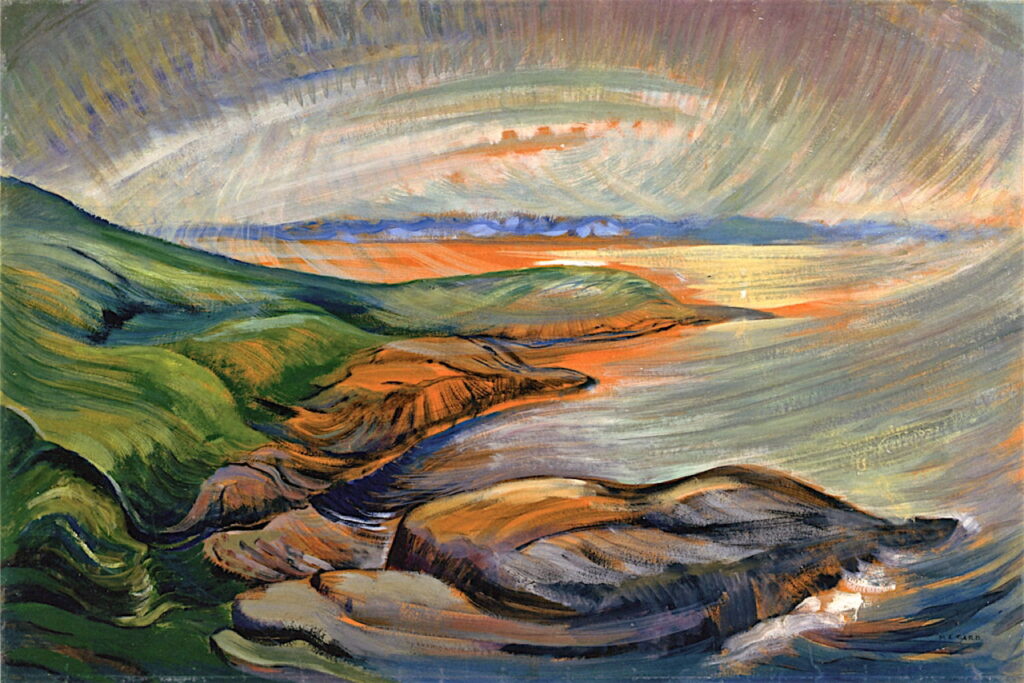Emily Carr’s paintings: Sculptural form 1931-1936

After more than a decade of neglect, Emily Carr’s art had finally achieved the recognition that it deserved during the late 1920s, and by 1930 her career was transformed. She was a national if not international success.
Emily Carr (1871–1945), Big Raven (1931), oil on canvas, 86.7 x 113.8 cm, Vancouver Art Gallery, Vancouver, BC. The Athenaeum.
Big Raven (1931) is one of Carr’s major works, and evolved from her original watercolour showing this massive totem at Cumshewa in 1912, through The Raven (1928-29), included in the previous article. Vegetation around the totem has transformed into viscous waves, swirling around the hillside and the base of the totem. The raven itself is a smooth, preternatural sculpted object. Even the sky now resembles the inside of a huge theatre, with sheets of light around. The whole painting has a monumental appearance, an elegiac gravity typical of her new approach to First Nations motifs.
Emily Carr (1871–1945), Zunoqua of the Cat Village (1931), oil on canvas, 112.2 x 70.6 cm, Vancouver Art Gallery, Vancouver, BC. The Athenaeum.
Zunoqua of the Cat Village (1931) shows a totem of particular interest to Carr, representing the female ogre Dzunukwa or Zunoqua. She is the ‘wild woman of the woods’, a thief of children but capable of bringing wealth to the Kwakwaka’wakw peoples. Carr wrote that she found these figures terrifying in their expression of power and domination. Scattered among the swirling vegetation are many cats, which look equally menacing.
As Carr returned to visit villages in the Haida Gwaii that she had last seen in about 1912, she noticed the changes that had taken place: suppression of the potlatch system, and clear-cutting of the forest. This comes through in these later paintings of First Nations cultures, as mourning for the disappearing people, a pervasive grief for what was rapidly being lost.
Emily Carr (1871–1945), Forest, British Columbia (1931-32), oil on canvas, 130 x 86.8 cm, Vancouver Art Gallery, Vancouver, BC. Wikimedia Commons.
Lawren Harris had advised Emily Carr to concentrate on “the tremendous elusive what lies behind” those First Nations villages, and during the 1930s she shifted her attention more to the forest and landscape. Forest, British Columbia (1931-32) is one of her finest paintings of a theme she had been developing since Totem Walk at Sitka (1907) and Wood Interior (1909), shown earlier in this series.
Its broken processional composition consists of a series of theatrical planes, behind which columns of tree-trunks recede into the depths. These are illuminated from within. Carr had been influenced by abstract art, although she didn’t intend to paint abstracts herself, producing many finished charcoal drawings of the interiors of forests as she worked her ideas up for these paintings.
Emily Carr (1871–1945), Old Tree at Dusk (c 1932), oil on canvas, 111.8 x 68.6 cm, McMichael Canadian Art Collection, Kleinburg, ON. The Athenaeum.
Old Tree at Dusk (c 1932) uses similar sculptural language in a more open setting, with the heightened drama of night. Her brushwork is also starting to build structure into the bark of the trees.
Emily Carr (1871–1945), Blue Sky (1932-34), oil on canvas, 95.3 x 66.1 cm, Private collection. The Athenaeum.
Blue Sky (1932-34) is another major work, showing a clearing with an elevated canopy formed by high trees. Her brushwork in the sky continues to become more structured, forming a high arch to echo that in the trees and resemble the interior of a cathedral.
In 1933, she bought a caravan which she named The Elephant, and had towed to different landscapes around Victoria to enable her to paint there. Two years later, Carr held her first solo exhibition in eastern Canada, hosted in Toronto by the Women’s Art Association of Canada.
Emily Carr (1871–1945), Seascape (c 1935), watercolour on masonite, 56.5 x 87.4 cm, National Gallery of Canada / Musée des beaux-arts du Canada, Ottawa, ON. The Athenaeum.
During the mid 1930s, Carr painted some wonderful coastal views, including her watercolour Seascape (c 1935). I suspect this is a view not too far from Victoria, where she lived. Unusually for watercolour, she appears to have used colour almost straight from the tube, and structured both land and sea with her brushstrokes.
Emily Carr (1871–1945), Young Pines and Sky (c 1935), oil on paper, 89.2 x 58.3 cm, Vancouver Art Gallery, Vancouver, BC. The Athenaeum.
Her Young Pines and Sky (c 1935) shows less sculptural form, and greater reliance on brushwork, both in forming the slender trees and in the arched cloud and sky.
Emily Carr (1871–1945), Scorned as Timber, Beloved of the Sky (1936), oil on canvas, 112 x 68.9 cm, Vancouver Art Gallery, Vancouver, BC. Wikimedia Commons.
She took the theme of exceptionally tall trees to its extreme in her Scorned as Timber, Beloved of the Sky (1936). Using a point of view close to the ground, in the middle of a cleared area, three isolated trees reach right up into the sky, where her patterned brushstrokes shimmer in the light.
Emily Carr (1871–1945), Strait of Juan de Fuca (c 1936), oil on paper, 60.7 x 91.3 cm, McMichael Canadian Art Collection, Kleinburg, ON. The Athenaeum.
Carr uses rich colours and intensely patterned brushwork in her dramatic Strait of Juan de Fuca (c 1936). This runs between Vancouver Island to the north, and the Olympic Peninsula, and her view captures the majesty of its scenery, sea and sky. The patterning of Carr’s brushstrokes and the sweep of the land to the left is echoed in an upward sweep apparent in the sea at the right. This suggests that she may have been envisioning the landscape through the optical distortion of a very wide-angle or fish-eye lens.
In the distance, on the opposite side of the strait, are the blue Olympic Mountains, contrasting with the rich green of the near shore at the left, and the orange-red of the sun.
Emily Carr was now 65, and finally established among the leading North American artists of the day. As the world headed inexorably towards war, her paintings were about to travel to Europe at last.
References
Wikipedia.
Lisa Baldissera (2015) Emily Carr, Life & Work, Art Canada Institute. ISBN 978 1 4871 0044 5. Available in PDF from Art Canada Institute.
Thom, Ian M (2013) Emily Carr Collected, Douglas & McIntyre. ISBN 978 1 77100 080 2.

